 In a News Item of 1 October, Over the Cliff, we looked at the passing of the deadline that same day for Congress to agree a budget. We also looked at the looming deadline for Congress to agree a new higher ceiling for Federal Government debt, currently standing at $16.699 trillion. Without an agreement to raise the limit, the government will start becoming unable to pay some of its bills from around 17 October.
In a News Item of 1 October, Over the Cliff, we looked at the passing of the deadline that same day for Congress to agree a budget. We also looked at the looming deadline for Congress to agree a new higher ceiling for Federal Government debt, currently standing at $16.699 trillion. Without an agreement to raise the limit, the government will start becoming unable to pay some of its bills from around 17 October.
One week on and no agreement has been reached on either a budget or a higher debt ceiling.
 Failure to agree on a budget has led to the ‘shut-down’ of government. Only essential services are being maintained; the rest are no longer functioning and workers have been sent home on ‘unpaid leave’. This has led to considerable hardship for many in the USA. It has had little effect, however, on the rest of the world, except for tourists to the USA being unable to visit various national parks and monuments.
Failure to agree on a budget has led to the ‘shut-down’ of government. Only essential services are being maintained; the rest are no longer functioning and workers have been sent home on ‘unpaid leave’. This has led to considerable hardship for many in the USA. It has had little effect, however, on the rest of the world, except for tourists to the USA being unable to visit various national parks and monuments.
Failure to raise the debt ceiling, however, could have profound consequences for the rest of the world. It could have large and adverse effects of global growth, global trade, global investment and global financial markets. The articles below explore some of these consequences.
U.S. Congress enters crucial week in budget, debt limit battles Reuters, Richard Cowan (7/10/13)
Debt ceiling: Understanding what’s at stake CBS Moneywatch, Alain Sherter (7/10/13)
Q&A: What is the US debt ceiling? BBC News, Ben Morris (3/10/13)
Five Reasons to Fear the Debt Ceiling Bloomberg (6/10/13)
A U.S. Default Seen as Catastrophe Dwarfing Lehma Bloomberg Businessweek, Yalman Onaran (6/10/13)
China tells US to avoid debt crisis for sake of global economy BBC News (7/10/13)
US shutdown is starting to hit business, says Commerce Secretary BBC News (6/10/13)
Why Australia should fear a US government default The Guardian, Greg Jericho (7/10/13)
Could the US default over just $6bn? BBC News, Linda Yueh (11/10/13)
IMF piles pressure on US to reconcile differences and prevent debt default The Guardian, Larry Elliott and Jill Treanor (10/10/13)
Republicans offer to raise US debt ceiling for six weeks The Telegraph, Peter Foster and Raf Sanchez (11/10/13)
Questions
- If a debt ceiling is reached, what does this imply for the budget deficit?
- How serious are the two current fiscal cliffs?
- How would a continuation of the partial government shut-down impact on the US private sector?
- What multiplier effects on the rest of the world are likely to arise from a cut in US government expenditure or a rise in taxes? What determines the size of these multiplier effects?
- Explain the likely effect of the current crisis on the exchange rate of the dollar into other currencies.
- Why might the looming problem of reaching the debt ceiling drive up long-term interest rates in the USA and beyond?
 For the second time in nine months, the USA has approached a fiscal cliff. This is where the federal government is forced to make government expenditure cuts and/or impose tax rises. There are two types of cliff face. The first is a legal limit on the size of the federal government debt and hence deficit. The second is failure to agree on a budget.
For the second time in nine months, the USA has approached a fiscal cliff. This is where the federal government is forced to make government expenditure cuts and/or impose tax rises. There are two types of cliff face. The first is a legal limit on the size of the federal government debt and hence deficit. The second is failure to agree on a budget.
On January 1st this year, a fiscal cliff was narrowly averted by a last-minute agreement to raise the size of the permitted debt. On the 1st October (the beginning of the financial year), however, the US economy ‘fell over the cliff’. This time is was a failure by Congress to reach agreement over the federal budget. The sticking point was an unwillingness of the Republican majority in the House of Representatives to agree to a budget without the government making concessions on its healthcare reform. The government was unwilling to do that and so no budget was passed.
With no budget, much of government has to shut down! In practice, this means that all non-essential workers will cease to be paid. 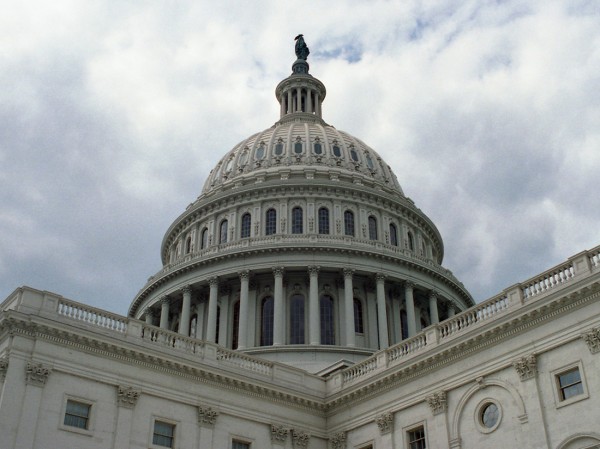 That includes workers in housing, parts of healthcare, the civil law part of the justice system, immigration, regulatory agencies, the passport service, parks and museums. Even workers in essential areas, such as civilian workers in the military, police and social services, are likely to see their pay delayed until the problem is resolved. The articles below look at some of the implications of this partial shut-down.
That includes workers in housing, parts of healthcare, the civil law part of the justice system, immigration, regulatory agencies, the passport service, parks and museums. Even workers in essential areas, such as civilian workers in the military, police and social services, are likely to see their pay delayed until the problem is resolved. The articles below look at some of the implications of this partial shut-down.
It is hoped that, within a few days, agreement on a budget will be reached. But that will not be the end of the story because a second fiscal cliff looms. And that is of the first type. There is currently a legal limit to Federal Government debt of $16.699 trillion. Because that limit was reached earlier this year, from May 18 the government has been able to use various ‘extraordinary measures‘ to carry on borrowing. These measures will run out, however, around 17 October. From then, if a new higher debt ceiling has not been agreed by Congress, the government will be unable to pay some of its bills. For example, on 1 November it will get a bill of $67billion for social security, medicare and veterans benefits. As the second Independent article below explains:
In a government shutdown, the federal government is not allowed to make any new spending commitments. By contrast, if we hit the debt-ceiling then the Treasury Department won’t be able to borrow money to pay for spending that Congress has already approved. In that case, either Congress will have to lift the debt ceiling or the federal government will have to default on some of its bills, possibly including payments to bondholders or Social Security payouts. That could trigger big disruptions in the financial markets — or a long-term rise in borrowing costs.
Not surprisingly, financial markets are nervous. Although the direct effect of lost output will be relatively small, provided agreements on the budget and the debt are reached fairly soon, the impact on confidence in the US system of government could be more damaging. Not only could this curb recovery in the USA, it could have a significant effect on global recovery, given the size and importance of the US economy to the rest of the world.
Webcasts
 What does the shutdown mean for normal Americans? BBC News, Keith Doyle (1/10/13)
What does the shutdown mean for normal Americans? BBC News, Keith Doyle (1/10/13)
 How the government shut down is being reported in the US BBC News (1/10/13)
How the government shut down is being reported in the US BBC News (1/10/13)
 Shutdown could slam frail U.S. economy Reuters, Bobbi Rebell (1/10/13)
Shutdown could slam frail U.S. economy Reuters, Bobbi Rebell (1/10/13)
 Shutdown Will Cost U.S. Economy $300 Million a Day, IHS Says Bloomberg, Jeanna Smialek & Ian Katz (1/10/13)
Shutdown Will Cost U.S. Economy $300 Million a Day, IHS Says Bloomberg, Jeanna Smialek & Ian Katz (1/10/13)
 How will the US government shutdown affect the global economy? The Guardian, Larry Elliott and Guy Grandjean (1/10/13)
How will the US government shutdown affect the global economy? The Guardian, Larry Elliott and Guy Grandjean (1/10/13)
 How would a government shutdown affect the rebounding economy? Aljazeera, Duarte Geraldino (30/9/13)
How would a government shutdown affect the rebounding economy? Aljazeera, Duarte Geraldino (30/9/13)
 How will the US government shutdown affect the economy? BBC News, Richard Lister (1/10/13)
How will the US government shutdown affect the economy? BBC News, Richard Lister (1/10/13)
 Shutdown continues as Obama and Republicans fail to agree BBC News, Rajini Vaidynathan (2/10/13)
Shutdown continues as Obama and Republicans fail to agree BBC News, Rajini Vaidynathan (2/10/13)
 Former US Secretary of Labor Robert Reich on shutdown BBC News, Robert Reich (2/10/13)
Former US Secretary of Labor Robert Reich on shutdown BBC News, Robert Reich (2/10/13)
 Government shutdown: What’s the cost? CBS News, Rebecca Kaplan (1/10/13)
Government shutdown: What’s the cost? CBS News, Rebecca Kaplan (1/10/13)
 US shutdown will have ‘minimal impact’ on global economy One News (New Zealand), Dan Zirker (2/10/13)
US shutdown will have ‘minimal impact’ on global economy One News (New Zealand), Dan Zirker (2/10/13)
 What is the US debt ceiling? BBC News, Hugh Pym (14/10/13)
What is the US debt ceiling? BBC News, Hugh Pym (14/10/13)
Articles
US wakes up to government shutdown as Congress fails to strike budget deal Independent, Nikhil Kumar (1/10/13)
US begins government shutdown as budget deadline passes BBC News (1/10/13)
David Cameron warns on world growth as US government shuts down The Telegraph, Damien McElroy (1/10/13)
Shutdown showdown: A glossary Aljazeera, Ben Piven (30/9/13)
Everything you need to know about how the partial shutdown will work in US Independent, Brad Plumer (1/10/13)
What’s the economic impact of a US government shutdown? BBC News, Kim Gittleson (1/10/13) (follow links at top of screen for further articles)
US government shutdown isn’t the worst of it BBC News, Linda Yueh (30/9/13)
Onset of the storm BBC News, Robert Peston (1/10/13)
The gathering storm? BBC News, Robert Peston (30/9/13)
Government shutdown: what’s really going on – and who’s to blame? The Guardian, Dan Roberts (30/9/13)
Government shutdown threat is getting very old, very fast CNN, Julian Zelizer (30/9/13)
US fiscal cliff fears rattle the markets The Australian, Adam Creighton (1/10/13)
U.S. Government Shutdown Sinks Dollar Forbes, Dean Popplewell (1/10/13)
US Government Shutdown: European Markets Not Fretting Over Temporary Closure International Business Times, Ishaq Siddiqi (1/10/13)
The States to plunge into abyss of debt, off fiscal cliff Pravda, Irina Sabinina (1/10/13)
Shutting down the United States government nothing new The Vancouver Sun, Andrew Coyne (1/10/13)
Christine Lagarde urges US that debt crisis threatens world economy The Guardian, Larry Elliott (3/10/13)
U.S. failure to lift debt ceiling could damage world – IMF Reuters (3/10/13)
Data
US government shutdown: in numbers The Guardian (see also)
US Budget: Historical Tables White House Office of Management and Budget (includes estimates to 2018 as well as historical data)
Questions
- If a debt ceiling is reached, what does this imply for the budget deficit?
- How serious are the two current fiscal cliffs?
- How would a continuation of the partial government shut-down impact on the US private sector?
- What multiplier effects on the rest of the world are likely to arise from a cut in US government expenditure or a rise in taxes? What determines the size of these multiplier effects?
- Explain the likely effect of the current crisis on the exchange rate of the dollar into other currencies.
- Why might the looming problem of reaching the debt ceiling drive up long-term interest rates in the USA and beyond?
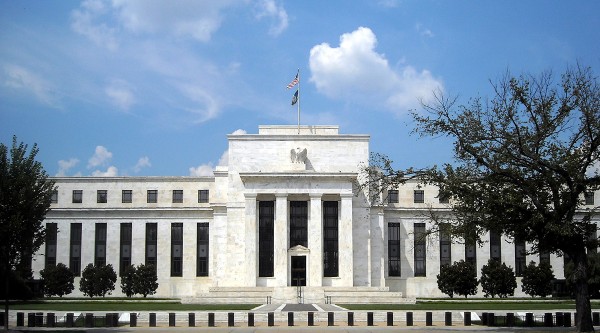 As we saw in the news item The difficult exit from cheap money, central banks around the world have been operating an extremely loose monetary policy since the beginning of 2009. Their interest rates have been close to zero and trillions of dollars of extra money has been injected into the world economy through various programmes of quantitative easing.
As we saw in the news item The difficult exit from cheap money, central banks around the world have been operating an extremely loose monetary policy since the beginning of 2009. Their interest rates have been close to zero and trillions of dollars of extra money has been injected into the world economy through various programmes of quantitative easing.
For the past few months the Federal Reserve has been purchasing bonds under its most recent programme dubbed QE3, and thereby increasing narrow money, by $85 billion per month. Since the start of its QE programme in 2009, it has pumped around $2.8 trillion of extra money into the US and world economies. This huge increase in money supply has boosted the demand for assets worldwide and world stock markets have risen. Much of the money has flowed into developing countries, such as India, and has acted as a boost to their economies.
 Once the US economy is growing strongly again, the aim is to taper off, and ultimately end or even reverse, the QE programme. It was expected that the Fed would decide to start this tapering off process at its meeting on 18 September – perhaps reducing bond purchases initially by some $10 billion. (Note that this would still be an increase in money supply, just a slightly smaller one.) Over the past few days, US bond prices have been falling (and yields increasing) in anticipation of such a move.
Once the US economy is growing strongly again, the aim is to taper off, and ultimately end or even reverse, the QE programme. It was expected that the Fed would decide to start this tapering off process at its meeting on 18 September – perhaps reducing bond purchases initially by some $10 billion. (Note that this would still be an increase in money supply, just a slightly smaller one.) Over the past few days, US bond prices have been falling (and yields increasing) in anticipation of such a move.
As it turned out, the Fed decided to delay tapering off. It will continue with its assets purchase programme of $85 billion per month for the time being. The reason given was that the US economy was still too fragile and needed the monthly injections of money to stay at the current level.
Normally it might be expected that the announcement of a more fragile recovery would cause the US stock market, and others worldwide, to fall. In fact the opposite occurred, with investors relieved that the extra money, which allows extra asset purchases, would continue at the same rate.
But this then raises the question of just what will be the effect when tapering off does actually occur. Will stock markets then go into a tailspin? Or will they merely stop rising so fast. That depends very much on the role of speculation.
Webcasts
 Bernanke’s Own Words on Asset Purchases, Economy Bloomberg (18/9/13)
Bernanke’s Own Words on Asset Purchases, Economy Bloomberg (18/9/13)
 Bernanke: Fed to delay bond tapering PBS Newshour on YouTube (full speech plus questions) (18/9/13)
Bernanke: Fed to delay bond tapering PBS Newshour on YouTube (full speech plus questions) (18/9/13)
 No tapering announced by Fed CNBC on Yahoo Finance (18/9/113)
No tapering announced by Fed CNBC on Yahoo Finance (18/9/113)
 The impact of US stimulus moves at home and abroad BBC News, Stephanie Flanders (18/9/13)
The impact of US stimulus moves at home and abroad BBC News, Stephanie Flanders (18/9/13)
 Is the upturn reaching Americans? BBC World, Stephanie Flanders (17/9/13)
Is the upturn reaching Americans? BBC World, Stephanie Flanders (17/9/13)
 Shares hit high as Federal Reserve maintains stimulus BBC News, Stephanie Flanders (18/9/13)
Shares hit high as Federal Reserve maintains stimulus BBC News, Stephanie Flanders (18/9/13)
 US Fed decision to delay tapering was a relief ET Now (India), Bimal Jalan (19/9/13)
US Fed decision to delay tapering was a relief ET Now (India), Bimal Jalan (19/9/13)
Articles
Federal Reserve surprises markets by delaying QE tapering The Telegraph, Katherine Rushton (18/9/13)
Federal Reserve delays QE tapering: the full statement The Telegraph (18/9/13)
Q&A: What is tapering? BBC News (18/9/13)
Fed delay is no reason to celebrate The Guardian, Larry Elliott (19/9/13)
Federal Reserve tapering decision has baffled the markets The Guardian, Larry Elliott (19/9/13)
Taper tiger The Economist (21/9/13)
Everything You Need to Know About the Fed’s Decision Not to Taper QE3 The Atlantic, Matthew O’Brien (18/9/13)
Fed’s dovish turn leaves Wall Street economists mulling taper timing: poll Reuters, Chris Reese (18/9/13)
Good news and bad news from the Fed BBC News, Stephanie Flanders (19/9/13)
Is the Fed frightened of its shadow? BBC News, Robert Peston (19/9/13)
The Federal Reserve and Janet Yellen face a tough task with insufficient tools The Guardian, Mohamed A. El-Erian (14/10/13)
Questions
- Why might a slowing down in the increase in US money supply cause asset prices to fall, rather than merely to rise less quickly?
- Why has the US QE programme led to a rise in asset prices overseas?
- Distinguish between stabilising and destabilising speculation. Which type of speculation has been occurring as a result of the US QE programme?
- How has QE affected unemployment in the UK and USA? How is the participation rate and the flexibility of labour markets relevant to the answer?
- Explain the following two statements by Stephanie Flanders and Robert Peston respectively. “The market conditions argument has a circularity to it: talk of tapering leads to higher market rates, which in turn puts the taper itself on hold.” “The Fed simply hinting that less money would be created, means that there will be no reduction in the amount of money created (for now at least).”
- Why have US long-term interest rates, including mortgage rates, risen since May of this year?
- What impact have higher US long-term interest rates had on economies in the developing world? Explain.
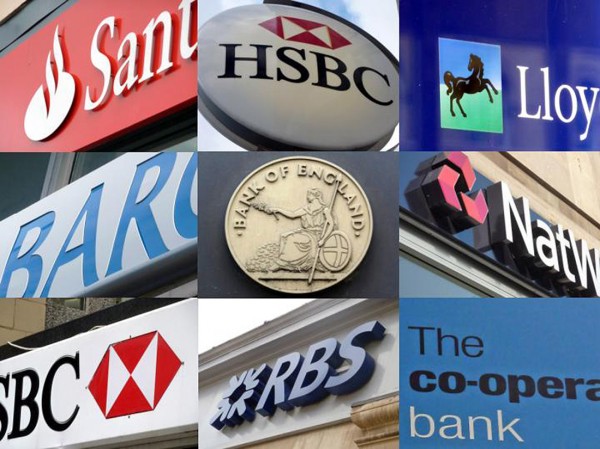 On 15 September 2008, Lehman Brothers, the fourth-largest investment bank in the USA, filed for bankruptcy. Although the credit crisis had been building since mid 2007, the demise of Lehmans was a pivotal event in the unfolding of the financial crisis and the subsequent severe recession in most developed economies. Banks were no longer seen as safe and huge amounts of government money had to be poured into banks to shore up their capital and prevent further bankruptcies. Partial nationalisation seemed the only way of rescuing several banks and with it the global financial system.
On 15 September 2008, Lehman Brothers, the fourth-largest investment bank in the USA, filed for bankruptcy. Although the credit crisis had been building since mid 2007, the demise of Lehmans was a pivotal event in the unfolding of the financial crisis and the subsequent severe recession in most developed economies. Banks were no longer seen as safe and huge amounts of government money had to be poured into banks to shore up their capital and prevent further bankruptcies. Partial nationalisation seemed the only way of rescuing several banks and with it the global financial system.
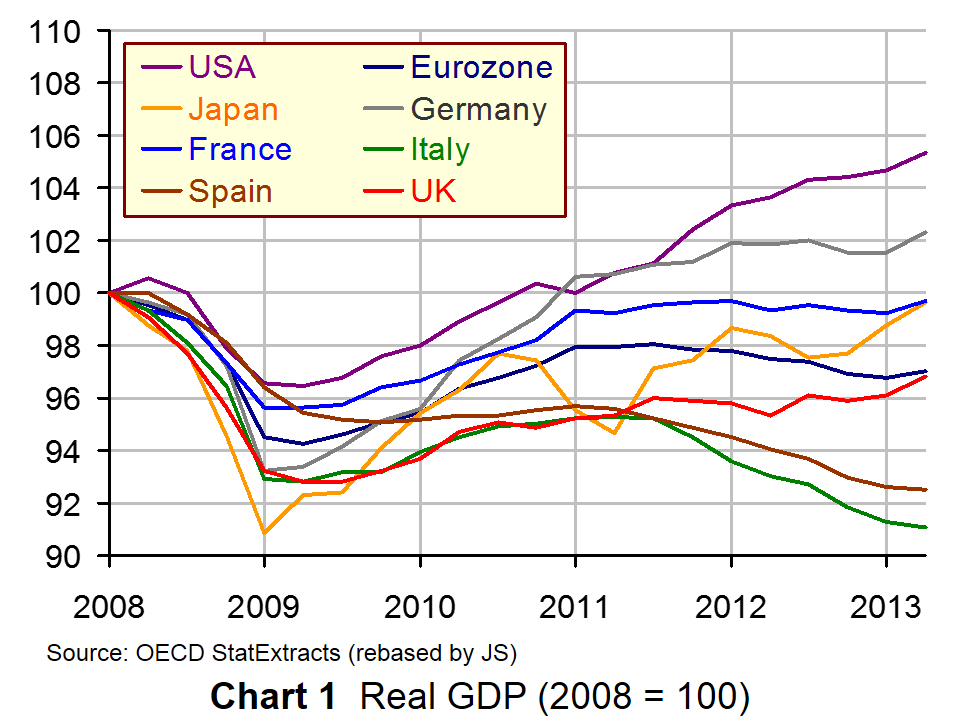 A deep and prolonged recession followed (see Chart 1: click here for a PowerPoint). In response, governments pursued expansionary fiscal policies – at least until worries about rising government deficits and debt caused a lurch to austerity policies. And central banks pursued policies of near zero interest rates and subsequently of quantitative easing. But all the time debate was taking place about how to reform banking to prevent similar crises occurring in the future.
A deep and prolonged recession followed (see Chart 1: click here for a PowerPoint). In response, governments pursued expansionary fiscal policies – at least until worries about rising government deficits and debt caused a lurch to austerity policies. And central banks pursued policies of near zero interest rates and subsequently of quantitative easing. But all the time debate was taking place about how to reform banking to prevent similar crises occurring in the future.
Solutions have included reform of the Basel banking regulations to ensure greater capital adequacy. 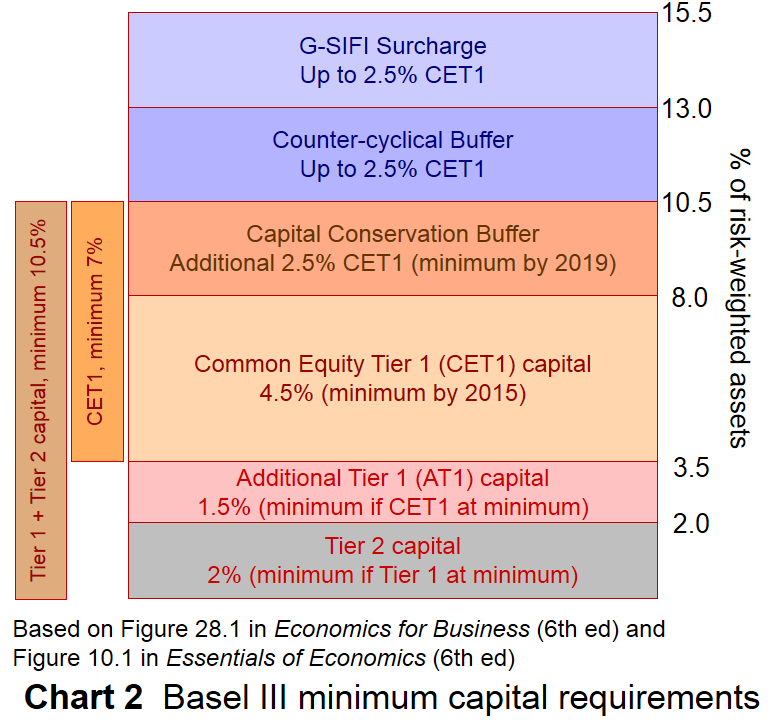 The Basel III regulations (see Chart 2) demand considerably higher capital ratios than the previous Basel II regulations.
The Basel III regulations (see Chart 2) demand considerably higher capital ratios than the previous Basel II regulations.
Other solutions have included proposals to break up banks. Indeed, just this week, the Lloyds Banking Group has hived off 631 of its branches (one sixth of the total) into a newly reformed TSB. Another proposal is to ring-fence the retail side of banks from their riskier investment divisions. In both cases the aim has been to avoid the scenario where banks are seen as too big to fail and can thus rely on governments to bail them out if they run into difficulties. Such reliance can make banks much more willing to take excessive risks. Further details of the new systems now in place are given in the Robert Peston article below.
But many critics maintain that not nearly enough has been done. Claims include:
• The Basel III rules are not tough enough and banks are still being required to hold too little capital.
• Rewards to senior bankers and traders are still excessive.
• The culture of banking, as a result, is still too risk loving in banks’ trading arms, even though they are now much more cautious about lending to firms and individuals.
• This caution has meant a continuing of the credit crunch for many small businesses.
• Higher capital adequacy ratios have reduced bank lending and have thus had a dampening effect on the real economy.
• The so-called ring-fences may not be sufficient to insulate retail banking from problems in banks’ investment divisions.
• Banks are not being required to hold sufficient liquidity to allow them to meet customers’ demands for cash in all scenarios.
• Banks’ reliance on each other still leaves a systemic risk for the banking system as a whole.
• Fading memories of the crisis are causing urgency to tackle its underlying problems to diminish.
• Problems may be brewing in less regulated parts of the banking world, such as the growing banking sector in China.
The following articles look at the lessons of the banking crisis – those that have been learned and those that have not. They look at the measures put in place and assess whether they are sufficient.
Lehman Brothers collapse, five years on: ‘We had almost no control’ The Guardian, Larry Elliott and Jill Treanor (13/9/13)
Lehman Brothers collapse: five years on, we’re still feeling the shockwaves The Guardian, Larry Elliott (13/9/13)
Five years after Lehman, could a collapse happen all over again? The Observer, Larry Elliott and Jill Treanor (15/9/13)
Five years after Lehman, all tickety-boo? BBC News, Robert Peston (9/9/13)
What have we learned from the bank crash? Independent, Yalman Onaran, Michael J Moore and Max Abelson (14/9/13)
We’ve let a good financial crisis go to waste since Lehman Brothers collapsed The Telegraph, Jeremy Warner (12/9/13)
 The Lehman legacy: Lessons learned? The Economist (9/9/13)
The Lehman legacy: Lessons learned? The Economist (9/9/13)
The dangers of debt: Lending weight The Economist (14/9/13)
The Lehman anniversary: Five years in charts The Economist (14/9/13)
Questions
- Why did Lehman Brothers collapse?
- Explain the role of the US sub-prime mortgage market in the global financial crisis of 2007/8.
- In the context of banking, what is meant by (a) capital adequacy; (b) risk-based capital adequacy ratios; (c) leverage; (d) leverage ratios?
- Explain the Basel III rules on (a) risk-based capital adequacy (see the textbook and the chart above); (b) non-risk-based leverage (introduced in 2013: see here for details).
- Explain and comment on the following statement by Adair Turner: ‘We created an over-leveraged financial system and an over-leveraged real economy. We created a system such that even if the direct cost of bank rescue was zero, the impact of their near-failure on the economy was vast.’
- Under what circumstances might the global financial system face a similar crisis to that of 2007/8 at some point in the future?
- Why is there an underlying conflict between increasing banks’ required capital adequacy and ensuring a sufficient supply of credit to consumers and business? What multiplier effects are likely to occur from an increase in the capital adequacy ratio?
 The 2020 Olympics has just been awarded to Tokyo, beating Madrid and Istanbul. Concerns over the safety of the games in Tokyo, with the city being perceived as relatively close to the Fukushima nuclear plant, were overcome with the help of an address by the Japanese Prime Minister, Shinzo Abe. So, what are the economic implications of this latest development in the sporting world?
The 2020 Olympics has just been awarded to Tokyo, beating Madrid and Istanbul. Concerns over the safety of the games in Tokyo, with the city being perceived as relatively close to the Fukushima nuclear plant, were overcome with the help of an address by the Japanese Prime Minister, Shinzo Abe. So, what are the economic implications of this latest development in the sporting world?
When London was awarded the 2012 Olympic Games, estimates suggested that it would generate a £16.5 billion contribution to GDP. With many new construction projects, there was the inevitable injection of government expenditure. This led to the creation of new jobs and thus successive employment multiplier effects were generated. This is also likely to be true for Tokyo, with current proposals suggesting that ten new permanent sites will be built to host the various sports of the Games. This will undoubtedly generate new jobs and will provide an almost certain boost to the construction industry. This, in turn, will generate further multiplier effects across a multitude of industries and across the rest of the country.
 There will also be further economic effects, for example on Japanese investment and stocks and shares, with a boost in confidence and optimism. A Tokyo-based fund manager, Hiroshi Fujumonto, said:
There will also be further economic effects, for example on Japanese investment and stocks and shares, with a boost in confidence and optimism. A Tokyo-based fund manager, Hiroshi Fujumonto, said:
Olympics-related stocks are yet to fully price in the decision, even though they’ve already outperformed … In the short term the entire Japanese share market will get a boost from celebratory buying and expectations for the event’s economic impact.
This was also confirmed by Shinzo Abe, when he commented after the victory was announced that ‘I want to make the Olympics a trigger for sweeping away 15 years of deflation economic shrinkage.’  The Japanese economy has been struggling for many years and this may be the much needed boost to the country’s optimism, infrastructure and economy.
The Japanese economy has been struggling for many years and this may be the much needed boost to the country’s optimism, infrastructure and economy.
As the world’s third largest economy, this economic boost is also likely to have knock-on effects on other countries across the world, though it is more likely to be the long-term impact that is important here. Just as it was with the London Olympics, the final effect and cost will only be known some years after the Olympics are held, but for now the work will start for Japan.
Olympics 2020: Tokyo wins race to host games BBC Sport (7/9/13)
Tokyo Olympics win seen boosting infrastructure, recovery Bloomberg, Yoshiaki Nohara and Satoshi Kawano (8/9/13)
Tokyo wins bid to host 2020 Olympic Games Telegraph, Ben Rumsby (8/9/13)
Tokyo chosen as ‘safe pair of hands’ to host 2020 Olympics Financial Times, Benedict Mander (8/9/13)
Japanese bid’s passion earns Tokyo the 2020 Olympic Games Guardian, Owen Gibson (7/9/13)
Olympics 2020: Why Tokyo is a ‘safe pair of hands’ to host Games BBC News, David Bond (8/9/13)
Questions
- What is the multiplier effect and how is it calculated?
- How can the overall economic benefits of the Olympic Games be estimated?
- Which industries in Tokyo are likely to be the ones that benefit from the Olympic Games?
- Outline a cost–benefit analysis of the Olympic Games.
- Why are share prices likely to go up in Japan based on this news? Look at both the demand and supply factors that will affect share prices.
- Is it possible that there will be wider multiplier effects on other countries besides Japan?
 In a News Item of 1 October, Over the Cliff, we looked at the passing of the deadline that same day for Congress to agree a budget. We also looked at the looming deadline for Congress to agree a new higher ceiling for Federal Government debt, currently standing at $16.699 trillion. Without an agreement to raise the limit, the government will start becoming unable to pay some of its bills from around 17 October.
In a News Item of 1 October, Over the Cliff, we looked at the passing of the deadline that same day for Congress to agree a budget. We also looked at the looming deadline for Congress to agree a new higher ceiling for Federal Government debt, currently standing at $16.699 trillion. Without an agreement to raise the limit, the government will start becoming unable to pay some of its bills from around 17 October. Failure to agree on a budget has led to the ‘shut-down’ of government. Only essential services are being maintained; the rest are no longer functioning and workers have been sent home on ‘unpaid leave’. This has led to considerable hardship for many in the USA. It has had little effect, however, on the rest of the world, except for tourists to the USA being unable to visit various national parks and monuments.
Failure to agree on a budget has led to the ‘shut-down’ of government. Only essential services are being maintained; the rest are no longer functioning and workers have been sent home on ‘unpaid leave’. This has led to considerable hardship for many in the USA. It has had little effect, however, on the rest of the world, except for tourists to the USA being unable to visit various national parks and monuments.








